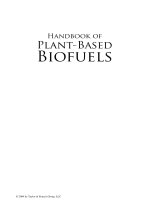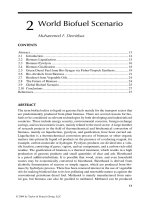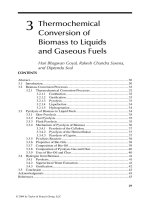Handbook of plant based biofuels - Chapter 19 potx
Bạn đang xem bản rút gọn của tài liệu. Xem và tải ngay bản đầy đủ của tài liệu tại đây (478.6 KB, 13 trang )
267
19
Biodiesel Production
from Mahua Oil and Its
Evaluation in an Engine
Sukumar Puhan, Nagarajan Vedaraman,
and Boppana Venkata Ramabrahmam
ABSTRACT
Vegetable oils and animal fats can be transesteried to biodiesel with alcohol for
use as an alternative to diesel fuel. This chapter deals mahua oil, its transfer into dif-
ferent esters, their performance and emission characteristics in a four-stroke, direct
injection diesel engine. The results showed that the thermal efciency was high in
the case of the methyl ester compared to other esters and to diesel fuel. The tail-pipe
emissions and noise levels were lower in the case of the methyl ester, compared to
those of diesel and other esters. The methyl ester dominated other esters on the basis
of engine performance and emissions and can be used as an alternative fuel for exist-
ing diesel engines.
CONTENTS
Abstract 267
19.1 Introduction 268
19.1.1 Worldwide Research on Vegetable Oil as Fuel 268
19.1.2 Mahua (Madhuca indica) Oil for Biodiesel Production 268
19.1.3 Transesterication 269
19.2 Properties 269
19.3 Engine Tests 270
19.3.1 Brake Specic Fuel Consumption 271
19.3.2 Specic Energy Consumption 271
19.3.3 Brake Thermal Efciency 272
19.3.4 Exhaust Gas Temperature 272
19.3.5 Noise Level 273
19.3.6 Oxides of Nitrogen 273
19.3.7 Carbon Monoxide Emission 275
19.3.8 Carbon Dioxide Emission 276
19.3.9 Hydrocarbon Emission 276
19.4 Conclusions 277
References 278
© 2009 by Taylor & Francis Group, LLC
268 Handbook of Plant-Based Biofuels
19.1 INTRODUCTION
Nearly a hundred years ago, Rudolf Diesel tested vegetable oil as fuel for diesel
engines. In the 1930s and 1940s vegetable oils were used as diesel fuels from time
to time, but usually only in emergency situations. Recently, because of the increase
in crude oil prices, dwindling resources of fossil fuel, and environmental concerns,
there has been a renewed focus on vegetable oils and animal fats that can be used as
biodiesel fuels in existing diesel engines. Biodiesel is, in principle, carbon dioxide
(CO
2
) neutral, that is, when plants grow, they absorb CO
2
, and after they are har-
vested, converted into biofuel, and burnt, CO
2
is produced. Ideally, a closed CO
2
circuit arises. The use of biodiesel has the potential to reduce the level of pollutants
and potential or probable carcinogens.
19.1.1 wo r l d w i d e re S e a r c H o n ve G e t a B l e oi l a S fu e l
Researchers have investigated the effect of using vegetable oils alone (Barsic and
Humke 1981; Frgiel and Varde 1981; Suda 1984; Murayama et al. 1984) or their blends
with diesel (Ziejewski and Kaufman 1983) in a diesel engine for extended periods of
time, and encountered a number of problems. Gerhard (1983) reported that the high
viscosity and low volatility of pure vegetable oil reduced the fuel atomization and
increased the fuel spray penetration. Higher spray penetration and polymerization
of the unsaturated fatty acids at higher temperatures are partly responsible for the
difculties experienced with engine deposits and thickening of the lubricating oil.
Several approaches have been undertaken to improve the physical properties of the
vegetable oil, for example, (1) the addition of chemicals (additives) to improve the
air-fuel mixture by decreasing the surface tension, (2) preheating to diminish the
viscosity for improving the internal formation of the mixture and combustion, and
(3) mixing with other fuels, to give a better internal formation of the air-fuel mixture
as a consequence of a lower viscosity of the blends or to initiate better burning by
easier burning components. These techniques are not suitable for long-term testing
(Last and Kruger 1985), hence, the derivatives of vegetable oils in the form of alkyl
esters and blends with diesel were more attractive as biodiesel. A number of studies
have been carried out on the preparation and engine testing of biodiesel from various
oils (canola [Spataru and Romig 1995], rapeseed [Staat and Gateau 1995], soybean
[Schumacher et al. 1996], palm [Kalam and Masjuki 2002], sunower [Da Silva,
Prata, and Teixeira 2003], karanja [Raheman and Phadatare 2004], and neem oil
[Nabi, Akhter, and Shahada 2006]).
19.1.2 ma H u a (ma d h u c a i n d i c a ) oi l f o r Bi o d i e S e l Pr o d u c t i o n
Mahua (M. indica) seed oil can be used for biodiesel manufacture. Its potential is
about 4,40,000 tonnes and only 10,000 tonnes are currently tapped and used, mainly
by the soap industry (Roma Rao, Nanda, and Kalpana Sastry 2003). M. indica is
a large deciduous tree with a short trunk, spreading branches, and large rounded
crown. The ower is used as a vegetable and as a source of alcohol. The cake from
the oil seeds is used as a fertilizer. Cattle eat the leaves, owers, and fruits. The ow-
ering season extends from February to April. The mature fruit falls to the ground
© 2009 by Taylor & Francis Group, LLC
Biodiesel Production from Mahua Oil and Its Evaluation in an Engine 269
in May to July in the north and August to September in south India. The yield of
the plant depends on the climatic conditions and varies from 5 to 200 kg/plant per
season, depending on the size and age of the plant. The mahua tree starts producing
seeds after 10 years and continues up to 60 years. The kernel constitutes about 70%
of the seed and contains 50% oil. The fats and oils are primarily water insoluble,
hydrophobic substances made up of one mole of the glycerol and three moles of the
fatty acids and are commonly referred to as the triglycerides. The fatty acids vary in
the carbon chain length and in the number of unsaturated bonds (double bonds). The
mahua oil contains approximately 47% saturated fatty acids and 53% unsaturated
fatty acids. Palmitic, stearic, and oleic acids are the major constituents.
19.1.3 tr a n S e S t e r i f i c a t i o n
The mahua oil was used to prepare mahua oil methyl ester (MOME), mahua oil
ethyl ester (MOEE), and mahua oil butyl ester (MOBE). Then their physical proper-
ties were determined and performance tested on a direct injection diesel engine to
determine the engine performance and exhaust emissions in comparison with No. 2
diesel fuel.
Good quality (≤1% free fatty acid and ≤0.5% moisture content) mahua oil (5 l)
was taken in a glass reactor tted with a stirrer, external heater, and condenser for
the transesterication processes. The oil was heated to 50ºC in the glass reactor and
NaOH dissolved in alcohol was added. The contents were heated to the required
temperature (between 60 and 110ºC). The reux condenser condensed the evapo-
rated alcohol back into the reactor. The stirring helped to achieve uniformity of the
reactants and helped the reaction go faster. Methanol, ethanol, and butanol (20, 30,
and 40 vol.% of oil, respectively) were used for the study. The reaction temperature
was xed in the range between 60 and 110
o
C at the boiling temperature of the cor-
responding alcohol and the reaction duration was xed at 2 h under the reux condi-
tion. After this, the reaction was stopped and the product was allowed to settle in
two layers. The upper layer consisted of the ester and alcohol and was separated from
the bottom layer (glycerin). The upper layer was distilled to remove and recover the
excess alcohol and the esters were washed with hot water to remove traces of the
glycerin and alkali. Finally, the product was dried for 1 h in a hot air oven at 105°C
and analyzed for the fuel properties as per the standard test methods and subse-
quently taken for the engine test.
19.2 PROPERTIES
Table 19.1 gives a summary of the fuel properties, such as the cetane number, higher
heating values, viscosity, specic gravity, ash point, pour point, sulfur content, and
moisture content of different mahua oil esters and the No. 2 diesel fuel. The cetane
number for butyl ester was higher compared to other esters and the diesel. The heat-
ing value increased with increase in the chain length of the fatty acid ester and
decreased with increase in the number of double bonds. The increase in the heat
content resulted from the increase in the number of carbons and hydrogen, as well
as increase in the ratio of these elements relative to oxygen. A decrease in the heat
© 2009 by Taylor & Francis Group, LLC
270 Handbook of Plant-Based Biofuels
content was the result of fewer hydrogen atoms (i.e., higher unsaturation) in the mol-
ecule. The viscosity of a liquid fuel is an important parameter because the uid has
to ow through pipelines, injector nozzles, orices, and for the atomization of the
fuel in the cylinder. Proper operation of an engine depends on the accepted viscos-
ity range of the liquid fuel. The viscosity of the mahua oil was quite high (38 cSt)
and reduced to approximately one-eighth to one-tenth of the value after the transes-
terication. The viscosity of all three alkyl esters was within the acceptable range
prescribed by the ASTM standards. The fuel consumption was signicantly affected
by the specic gravity of the fuel. If the specic gravity is more, the fuel is more
concentrated and more fuel is likely to deliver on the mass basis, which leads to a
higher fuel consumption. The MOAE has specic gravity within the range specied
by ASTM standards. The ash point measures the tendency of the sample to form
a ammable mixture with air under controlled conditions. This is the property that
must be considered in assessing the overall ammability hazard of a material. The
ash point of the MOAE was signicantly higher than that of diesel fuel and thus
would be quite safe for use in transportation compared to diesel. The cloud point for
the MOAE was closer to that of diesel fuel.
19.3 ENGINE TESTS
The performance and emissions of the MOAE were studied in the diesel engine in
comparison with the No. 2 diesel fuel. The engine used for the study was a single-
cylinder, four-stroke, constant-speed, vertical, water-cooled, direct injection (DI),
3.68 kW diesel engine. The engine was coupled to a swinging eld separating excited
type DC generator and loaded by electrical resistance. The exhaust gas temperature
was measured by an iron-constantan thermocouple. The oxides of nitrogen (NOx),
carbon monoxide (CO), carbon dioxide (CO
2
), and hydrocarbon (HC) were measured
by the MRU emission monitoring systems DELTA 1600-L and MRU OPTRANS
1600. The fuel consumption was measured by a U-tube manometer. The engine was
started in neat diesel fuel and warmed up. The warm-up periods ended when the
TABLE 19.1
Properties of Mahua Esters in Comparison with No. 2 Diesel and ASTM
Standards
Properties Diesel MOME MOEE MOBE
ASTMD6751
FAME
Cetane no. 46 51 52 54 ≥47
Higher heating value MJ/Kg 45 39.276 40.528 41.607 –
Kinematic viscosity (cSt) 2.4 4.2 5.4 4.7 1.9–6.0
Specic gravity 0.82 0.865 0.875 0.854 0.87–0.90
Flash point (ºC) 70 157 174 164 ≥130
Pour point (ºC) -10–-15 -3–-5 0–-1 -3–-1
Sulphur content – 0.02% 0.04% 0.03% 0.05
Moisture content – 0.01% 0.01% 0.01% ≤0.05%
© 2009 by Taylor & Francis Group, LLC
Biodiesel Production from Mahua Oil and Its Evaluation in an Engine 271
cooling water temperature was stabilized. Then the fuel consumption, exhaust gas
temperature, and different exhaust emissions were measured. The procedure was
repeated for MOME, MOEE, and MOBE.
19.3.1 Br a K e SPe c i f i c fu e l co n S u m P t i o n
The brake specic fuel consumption (BSFC) is the mass of fuel required to develop
unit brake power. It can be seen from Figure 19.1 that the BSFC was higher for all
the ester-based fuels compared to diesel. This was due to the higher specic grav-
ity and lower heating value of the MOAE compared to the No. 2 diesel. The methyl
ester showed better BSFC compared to the others. The BSFC values were 0.299,
0.319, 0.342, and 0.324 kg/kW-h correspondingly for the diesel, MOME, MOEE,
and MOBE at full load.
19.3.2 SP e c i f i c en e r G y co n S u m P t i o n
Figure 19.2 shows a comparison of the specic energy consumption (SEC) between
the different esters and the No. 2 diesel. The reason for taking SEC into account
is that comparison of thermal efciency for different fuel becomes easier. As the
thermal efciency depends on two variables, specic fuel consumption and heating
value, the comparison will be difcult unless we know the individual contribution
of the variables. The product of specic fuel consumption and heating value is
0
01234567
0.1
0.2
0.3
0.4
0.5
0.6
0.7
0.8
BMEP (bar)
BSFC (Kg/kW-hr)
Diesel
MOME
MOEE
MOBE
FIGURE 19.1 Variation of brake specic fuel consumption with brake mean effective pressure.
© 2009 by Taylor & Francis Group, LLC
272 Handbook of Plant-Based Biofuels
called specic energy consumption, which does not relate to any unit. The values
for the diesel, MOME, MOEE, and MOBE were 3.784, 3.525, 3.779, and 3.744,
respectively, at full load. SEC was less for the MOME compared to other two
esters.
19.3.3 Br a K e tH e r m a l ef f i c i e n c y
Figure 19.3 shows a comparison of the brake thermal efciency (BTE) between the
different esters and No. 2 diesel. The BTE is purely dependent on the engine design,
type of fuel used, and the area of use. The vegetable oil-based fuel contains oxy-
gen ranges of 10 to 12% and combustion is better in the case of the MOAE com-
pared to the diesel. The bonded oxygen helps the fuel to burn efciently inside the
combustion chamber, thereby releasing more heat. Again, the heat release does not
only depend on the oxygen content but also the heating value of the fuel. Since the
vegetable oil-based fuels have 10 to 12% less heating value compared to diesel fuel,
the oxygen content and heating value of the fuel are together responsible for the ther-
mal efciency. The data showed that the thermal efciency for the methyl ester was
high compared to those of the diesel and other esters at the full load.
19.3.4 ex H a u S t Ga S te m P e r a t u r e
Figure 19.4 shows a comparison of the exhaust gas temperature (EGT) between the
MOAE and diesel. In the diesel engine, there are four stages in the combustion pro-
0
01234567
1
2
3
4
5
6
7
8
9
BMEP (bar)
SEC
Diesel
MOME
MOEE
MOBE
FIGURE 19.2 Variation of specic energy consumption with brake mean effective pressure.
© 2009 by Taylor & Francis Group, LLC
Biodiesel Production from Mahua Oil and Its Evaluation in an Engine 273
cess: ignition delay, premix combustion or uncontrolled combustion, controlled com-
bustion, and afterburning. If the afterburning phase is more or the engine misres
or the injection time is not proper, then there is every possibility for higher EGT. On
the other hand, if the combustion process is perfect, then also the EGT is likely to
be high. As the thermal efciency was higher in the case of the methyl ester of the
mahua oil, the combustion process was supposed to be more complete and this could
be one reason for a higher EGT.
19.3.5 no i S e le v e l
Figure 19.5 shows the variation of the noise level with load for different fuels.
The noise is the indication of the sound that is created during the running of an
engine. The result showed that at 100% load of the engine, the noise level for all
the esters was low compared to diesel and the lowest noise level observed was
123 dB in the case of methyl ester compared to 169 dB for the No. 2 diesel at the
same load condition.
19.3.6 ox i d e S o f ni t r o G e n
Figure 19.6 shows a comparison of the NO
X
emission between the different esters and
the diesel. The oxides of nitrogen are formed inside a diesel engine due to high ame
0
5
10
15
20
25
30
0
BMEP (bar)
Brake ermal Efficiency (%)
Diesel
MOME
MOEE
MOBE
7654321
FIGURE 19.3 Variation of brake thermal efciency with brake mean effective pressure.
© 2009 by Taylor & Francis Group, LLC
274 Handbook of Plant-Based Biofuels
0
0 1.77 3.11 4.89 6.22
50
100
150
200
250
300
350
400
450
500
BMEP (bar)
EGT
Diesel
MOME
MOEE
MOBE
FIGURE 19.4 Variation of exhaust gas temperature with brake mean effective pressure.
0
0 1.77 3.11 4.89 6.22
20
40
60
80
100
120
140
160
180
BMEP (bar)
NOISE (db)
Diesel
MOME
MOEE
MOBE
FIGURE 19.5 Variation of noise with brake mean effective pressure.
© 2009 by Taylor & Francis Group, LLC
Biodiesel Production from Mahua Oil and Its Evaluation in an Engine 275
temperature, peak pressure inside the cylinder, nitrogen content of the parent fuel,
and the residence time of the fuel inside the cylinder. All these factors affect NO
X
emission greatly. As the cetane number of the ester-based fuel is high compared to
diesel, the residence time may be less in the case of ester-based fuel. In addition, the
oxygen content of the fuel enhances the ignition quality, thereby reducing delay for
esters. Hence, the MOAE is likely to produce lower heat release at the premix com-
bustion phase, and this would lower the peak combustion temperature and reduce the
NO
X
emissions. In addition, other parameters such as iodine value, chemical bond-
ing, and structure may contribute to a lower combustion temperature.
19.3.7 ca r B o n mo n o x i d e em i S S i o n
Figure 19.7 shows a comparison of CO emission between the different esters and the
diesel. CO emission depends on the combustion efciency and carbon content of the
fuel. This shows how efciently the fuel is burnt inside the engine cylinder. The fuel,
during combustion, undergoes a series of oxidation and reduction reactions. The car-
bon content of the fuel is oxidized with the oxygen available in the air to CO and sub-
sequently to CO
2
. No fuel will give 100% combustion efciency, so the carbon that
is not converted to CO
2
will come out as CO in the exhaust. The test results showed
that for all the esters, the CO emission was lower than that of diesel and the methyl
ester gave the lowest CO emission level compared to the other two esters (0.07% for
the methyl ester; 0.34 % for the diesel at full load).
0
100
200
300
400
500
600
700
800
900
1000
04
BMEP (bar)
NOx (ppm)
Diesel
MOME
MOEE
MOBE
765321
FIGURE 19.6 Variation of NOx with brake mean effective pressure.
© 2009 by Taylor & Francis Group, LLC
276 Handbook of Plant-Based Biofuels
19.3.8 ca r B o n di o x i d e em i S S i o n
Figure 19.8 shows a comparison of the CO
2
emissions between the different esters
and the No. 2 diesel. Carbon dioxide emission is likely to be more for fuel with better
combustion quality. The better the combustion, the more carbon as carbon dioxide
is present in the exhaust. Actually, all the carbon present in the fuel cannot be con-
verted to carbon dioxide. As the esters contained oxygen in the chemical structure,
the combustion was better than with No. 2 diesel. Hence, the carbon dioxide emis-
sion in the exhaust was more than that observed for the diesel.
19.3.9 Hy d r o c a r B o n em i S S i o n
Figure 19.9 shows a comparison of the HC emission between the different esters and
the diesel. The hydrocarbon present in the fuel is burnt inside the engine cylinder
in the presence of air. The amount of HC that is not taking part in the combustion
reaction is likely to come out as unburnt hydrocarbon. As explained earlier, due to
several reasons, combustion is not 100% perfect. Hence, the HC emission is likely
to occur in the exhaust system. In the case of ester-based fuels, the oxygen present
in the structure helps in better combustion and hence HC emission is less than that
of diesel. The results showed that the HC value for the No. 2 diesel was 89 ppm,
whereas it was 35, 45, and 50 ppm for methyl, ethyl, and butyl esters, respectively,
at full load.
0
0.05
0.1
0.15
0.2
0.25
0.3
0.35
0.4
04
BMEP (bar)
CO (% Vol.)
Diesel
MOME
MOEE
MOBE
765321
FIGURE 19.7 Variation of CO with brake mean effective pressure.
© 2009 by Taylor & Francis Group, LLC
Biodiesel Production from Mahua Oil and Its Evaluation in an Engine 277
19.4 CONCLUSIONS
Plant–based renewable fuels were obtained by the transesterication of mahua
oil with different alcohols and tested in a single-cylinder DI diesel engine. The
MOME, MOEE, and MOBE were evaluated in terms of engine performance and
emissions. The CO emissions from the MOME, MOEE, and MOBE were lower
than those from diesel fuel at full load. The CO
2
emission was slightly more com-
pared to the diesel because of better combustion in the case of the MOME, MOEE,
and MOBE. The NO
x
emissions for all the esters were lower than that of the diesel.
Hence, in terms of the performance and emission characteristics, the MOAE may
be regarded as a potential substitute for diesel fuel. Among the esters, the mahua
methyl ester was the best choice because of its low alcohol cost, low reaction tem-
perature, relatively lower emission, and better engine performance compared to
the other two esters.
0
01234567
1
2
3
4
5
6
7
8
9
BMEP (bar)
CO
2
(% Vol.)
Diesel
MOME
MOEE
MOBE
FIGURE 19.8 Variation of CO
2
with brake mean effective pressure.
© 2009 by Taylor & Francis Group, LLC
278 Handbook of Plant-Based Biofuels
REFERENCES
Barsic, N. J. and A. L. Humke. 1981. Performance and emission characteristics of a naturally
aspirated diesel engine with vegetable oil fuels. SAE Paper No- 810262. Warrendale,
PA: SAE International.
Da Silva, F. N., A. S. Prata, and J. R. Teixeira. 2003. Technical feasibility assessment of oleic
sunower methyl ester utilization in diesel bus engines. Energy Conversion and Man-
agement 44: 2857–2878.
Forgiel, R. and K. S. Varde. 1981. Experimental investigation of vegetable oil utilization
in direct injection diesel engines. SAE Paper No. 811214. Warrendale, PA: SAE
International.
Gerhard, V. 1983. Performance of vegetable oils and their monoesters as fuels for diesel
engines. SAE Paper 831358. Warrendale, PA: SAE International.
Kalam, M. K. and H. H. Masjuki. 2002. Biodiesel from palm oil: An analysis of its properties
and potential. Biomass and Bioenergy 23: 471–479.
Last, R. J. and M. D. H. Kruger. 1985. Emission and performance characteristics of a four
stroke, direct injected diesel engine fuel with blends of bio diesel and low sulfur diesel
fuels. SAE Paper No. 850054. Warrendale, PA: SAE International.
Murayama, T., Y T. Oh, N. Miyamoto, T. Chikahisa, N. Takagi, and K. Itow. 1984. Low
carbon ower buildup, low smoke, and efcient diesel operation with vegetable oils
by conversion to mono-esters and blending with diesel oil or alcohols. SAE Paper No.
841161. Warrendale, PA: SAE International.
0
01234567
10
20
30
40
50
60
70
80
90
100
BMEP (bar)
HC (ppm)
Diesel
MOME
MOEE
MOBE
FIGURE 19.9 Variation of hydrocarbon with brake mean effective pressure.
© 2009 by Taylor & Francis Group, LLC
Biodiesel Production from Mahua Oil and Its Evaluation in an Engine 279
Nabi, M. N., M. S. Akhter, and M. M. Z. Shahadat. 2006. Improvement of engine emissions
with conventional diesel fuel and diesel-biodiesel blends. Bioresource Technology 97:
372–378.
Raheman, H. and A. G. Phadatare. 2004. Diesel engine emission and performance from
blends of karanja methyl ester and diesel. Biomass and Bioenergy 27: 393–397.
Roma Rao, R. D., S. K. Nanda, and R. Kalpana Sastry. 2003. Strategies for Augmenting
Potential of Vegetable Oils as Biodiesel. Tree-Borne Oil Seeds as a Source of Energy
for Decentralized Planning. Renewable Energy Science Series XII. Ministry of Non-
Conventional Energy Source, Government of India.
Schumacher, L. G., S. C. Borgelt, D. Fosseen, W. Goetz, and W. G. Hires. 1996. Heavy duty
engine exhaust emission tests using methyl ester soybean oil/diesel fuel blends. Biore-
source Technology 57: 31–36.
Spataru, A. and C. Romig. 1995. Emissions and engine performance from blends of soya and
canola methyl esters with ARB#2 diesel in a DCC 6V92TA MUI engine. SAE Paper
No. 952388. Warrendale, PA: SAE International.
Staat, F. and P. Gateau. 1995. The effects of rapeseed oil methyl ester on diesel engine per-
formance exhaust emissions and long-term behavior: A summary of three years of
experimentation. SAE Paper No. 950053. Warrendale, PA: SAE International.
Suda, K. J. 1984. Vegetable oil or diesel fuel: A exible option. SAE Paper No: 840004. War-
rendale, PA: SAE International.
Ziejewski, M. and K. R. Kaufman. 1983. Laboratory endurance test of a sunower oil blend
in a diesel engine. J. Am. Oil Chem. Soc. 60 (8): 1567–1573.
© 2009 by Taylor & Francis Group, LLC









